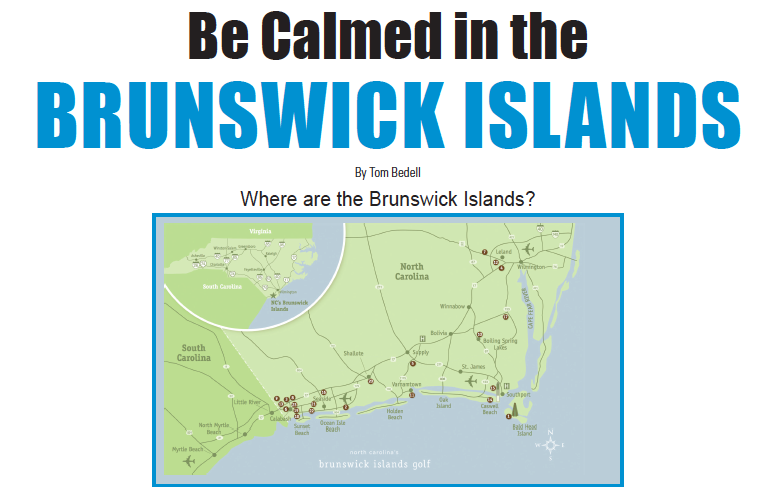Let’s start with the Brunswick Islands, five barrier islands, six world-class beaches and ten communities perched in the southeast corner of North Carolina, tracing a crescent from the South Carolina border up to the Cape Fear River. It’s about a half-hour from North Myrtle Beach and the beginning of the Grand Strand. But if we think of Myrtle Beach as basically turning the volume up to 11, the Brunswick Islands hums along at a lower volume and less frenetic pace.
It also has 30 golf courses and some of the best seafood around (often cooked in what is called Calabash-style, lightly battered and seasoned. That makes it ideal for golfers looking to play as much as they want, at bargain rates, without any teeming sense of haste.
Some friendly number cruncher figured out that the 30 courses on the Brunswick Islands golf menu worked out to 120 miles of fairways, 585 holes and 15 architects (also throwing in 45 miles of beaches). There’s plenty of variety in the play, to be sure. There was actually plenty right at the resort we stayed at in Sunset Beach, Sea Trail, which has three courses, not to mention a full-blown convention center.
On my visit we played two of them, the Byrd Course (as in designer Willard Byrd), and the Jones Course (Rees Jones). Next time around for the Maples Course, said to be one of Dan Maples’ finest, playing among old oaks and Carolina pines, with five holes skirting the Calabash Creek.
It’s true that one’s sense of agreeable indolence in the Brunswick Islands can be compromised by a bad round out on the greensward, but neither the Byrd nor Jones courses, both of which opened in 1990 and share a clubhouse, seemed terribly exacting, with 125 slopes from the under 6,500-yard tee boxes. The Byrd skirts a variety of man-made lakes, which means players may need to skirt a gator or two, as we did, and heed the starting sign to avoid feeding the alligators or, “They May Become Aggressive.”
Water, or avoiding it, is also key on the Jones Course, as it comes into play on 11 holes. The fairways are wide, the mounding is ample, and large bunkers alternate with pesky pot bunkers to complicate matters. The Open Doctor approved some renovations to his own course, which was a qualifier for the 2006 U.S. Open.
We actually started out our visit with the most highly touted area course, if one is glancing at the Golfweek Best Courses You Can Play in North Carolina list, at any rate, where Cape Fear National will be found. We found it in Leland, a Tim Cate design, and it was a splendid introduction, a natural wonder built in and around a community development called Brunswick Forest.
Plenty of trees, in other words, but as Cate is also a landscape architect, the flora and fauna throughout are fairly jaw-dropping—cochina rock walls, boulders, pampas grass, weeping love grass, cord grass, cypress marsh and wetlands, drive-through waste areas, 1,500 feet of bridges—it’s enough to make one forget about
Cape Fear has five tee boxes, but suggests four slope-rated hybrid routes as well, essentially offering nine different length options for players, from 4,743 to 7,217 yards. Why don’t more courses do this?
The Rivers Edge Golf Club was a favorite of some players in our group. An Arnold Palmer design in Shallotte, the course plays along the bluffs and tidal marshes of the Shallotte River, and leads up to a final four holes called “the finish on the river.” By the time we reached 15 on a sunny afternoon the sense of peace and quietude was such that I finished the closing quartet in even par.
We had a notable round at Compass Point Golf Club, which is also the subject of some local golf trivia: What was the last full 18-hole course built in North Carolina? Right, Rick Robbins’ design in Leland. Robbins also lives at the development surrounding the course, was having lunch as we finished the round and before too long had joined us.
The president of the American Society of Golf Course Architects in 2013-2014, Robbins is a personable fellow, and we were soon looking over course diagrams of projects he’s working on in China and listening to stories about how he once actually managed to get Robert Trent Jones Jr. and Rees Jones to pose together for a photograph.
He was pleased with Compass Point: “We started with mostly pine forest here. It reminded me of Pinehurst,
and we have similar push up greens. From the start we wanted firm and fast fairways, with open fronts to all the greens.” The well-draining sandy soil helped out there. And, for a coastal course, there’s a near-startling 75 feet change in elevation.
Robbins has done about 150 courses in his career, which has included work with Robert von Hagge and Jack Nicklaus. One of those is another Brunswick Islands course—Crow Creek Golf Club in Calabash.
Now that you know where the Brunswick Islands are… it may be time for you to tee it up there.
Tom Bedell is usually pretty calm wherever he is, except after triple bogeys.
Originally published in New York Golfing Magazine, Summer 2018 issue

